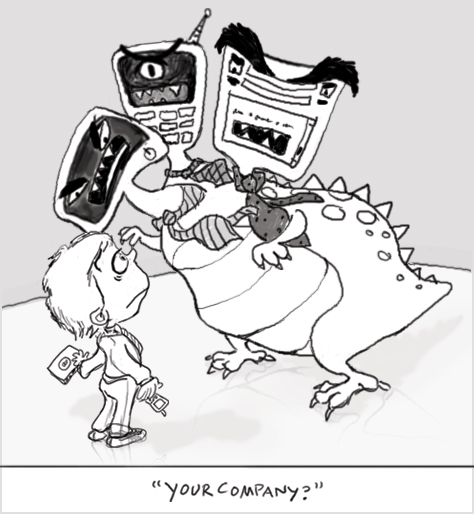Why Conversing Across Channels Is Hard
We’ll never overcome the barriers to effective cross-channel conversation if we don’t understand what factors make it hard. As G.I. Joe says, “Knowing is half the battle.” A number of significant issues make cross-channel conversation difficult, including
- organizational issues
- technology issues
- content and design issues
Organizational Issues
Many organizational issues contribute to the cross-channel challenge. I believe many of these issues stem from focusing too much on efficiency and not enough on quality. While I value efficiency and understand the business need to make conversations with customers efficient, I’m also convinced of a very strong business need for quality in customer conversations.
- Marketing, sales, and customer service converse with customers in isolation, not through coordination. Generally, the marketing and sales roles focus on sending messages to customers, while the customer service role focuses on helping customers solve problems. Unfortunately, companies sometimes incorrectly map these roles to channels. For instance, marketing might own the Web site while customer service owns the IVR. On the other hand, customers often have both a sales or marketing need and a customer service need they want to satisfy through the same experience—that is, via one channel. So, conversations that are limited strictly to one purpose and one purpose only are at best unnatural.
- Many call and chat centers focus more on completing calls quickly than on resolving customers’ issues. Live help, whether on the phone or over chat, costs money. Understandably, most companies like to save costs in this area. One way companies try to do so is to handle calls quickly. Call centers’ training, scripts, and tools focus heavily on the metric of call length. The problem? The call-length metric can overshadow another important metric, reducing repeat inquiries—or conversely, increasing the number of first-inquiry resolutions. Addressing a customer’s need correctly and completely requires fully understanding the customer’s need, which requires listening to the customer. Listening, an important element of conversation, might add time to a call, but likely will prevent the need for more calls, email messages, or other inquiries from the same customer about the same issue.
- Outsourcing and offshoring customer service complicate conversations with customers. Both outsourcing and offshoring introduce communication noise that distracts customers. For instance, when a company outsources live chat support, the risk arises that chat agents might answer questions without fully understanding the company’s policies and latest offers, or they might follow a strict script, even when it doesn’t make sense for the customer’s need. Offshoring call centers can result in agents who speak in a non-native language and use tactics such as fake names to attempt to seem more native, arousing customer mistrust. Agents speaking in a non-native language also might have difficulty understanding a customer’s use of idioms or slang, which in turn can make them slower to understand and address a customer’s need, defeating the goal of completing calls quickly and possibly preventing the successful resolution of an issue, as well.
- Decentralized content creation complicates the conversation. Often, though a company does not outsource or offshore content writing for a Web site or Web development, it distributes these tasks across the organization or its suppliers. For instance, a large retailer might rely on product manufacturers to provide content about their products for the Web site. This results in significant inconsistencies in the tone, amount, and quality of content, which may vary widely across products. Customers have to work hard to understand what the company is trying to say about its products, especially when comparing different products.
- Channels compete instead of coordinate. Some companies pit channels against each other, especially for sales. As a result, each channel works in isolation, encouraging or forcing customers to continue using the same channel. This self-serving effort conflicts with customers’ natural behaviors and prevents their using the channel that is most convenient or effective for them, which can vary based on age, stage in the buying process, location, time of day, and more. This competition also results in inconsistent and confusing information across channels.
Technology Issues
Technology is partly responsible for the existence of multiple channels and has tremendous potential for helping companies converse well across them. The mistake many companies make is thinking technology alone can address the challenge. It cannot. You still have to think—about your business processes across channels, what you’re trying to say to customers across channels, how to respond to customers’ needs across channels, and more.
- Content management systems, by themselves, do not meet the challenge. Content management systems are wonderful technology. They help us repurpose content across multiple areas on a Web site and, potentially, across multiple channels. Used well and with good content, this capability is very powerful. Used poorly and with bad content, it only magnifies how bad your content is. Content management systems also allow multiple content authors. This capability is very powerful when used well, as part of a coordinated effort. Used poorly, it lets many different authors with many different voices and motivations create content, resulting in an inconsistent voice and providing potentially conflicting messages. In the end, content management systems are tools. How we use them determines whether they help us converse well across channels.
- Customer relationship and case management systems, by themselves, do not meet the challenge. Customer relationship and case management systems also are wonderful technology. They track customer behavior, customer contact information, the status of customer cases, and more. Unfortunately, they are not always capable of incorporating all of the information that call, chat, or store agents really need to address customer inquiries. So, agents must work in many applications during a single conversation, making their calls take longer and impairing their ability to listen to customers. An alternative, and sometimes just as undesirable, approach is trying to integrate the information into the customer relationship or case management application through heavy customization. Often this customization changes the application to the point that it’s not possible to upgrade consistently, which can affect the application’s performance. As a consequence, the application might update customer information slowly, load pages slowly, and so on.
Content and Design Issues
Inconsistent content and poor design make talking with customers effectively across channels nearly impossible. Content and design issues typically result from the following problems:
- The design of customer relationship and case management tools is often inadequate. If such tools are not efficient to use and do not clearly communicate information about a customer or a case, they do not help your sales or customer service agents converse well with customers. Common tasks need to be easy to do. The dashboard for a customer or a case should prioritize the most useful information and give quick access to details. Links to related information or applications need to be easily available. Text must be easy to read. Agents need to be able to take notes while viewing information. I could go on and on!
- Many scripts and content references for agents are poorly written. I have great respect for call or chat centers and their agents. Trying to do an agent’s job of balancing so many tools, while working quickly and keeping a customer happy, would blow my mind. But I do not think they dedicate the necessary time or resources to writing good scripts or content to support the agents. For instance, at Cingular Wireless, representatives used the terms power on and power off instead of turn on and turn off, because that’s what was in the documentation. Just that little term alone caused confusion for customers. Who says Power on your phone?
- Chat agents might not be trained to communicate in writing. Some companies have moved agents from the phone to chat. People who were hired to speak to customers are now writing to them via chat. Your customers can copy and paste chat transcripts—unless that capability is turned off, which I do not recommend. The words in chat transcripts—jargon, typos, bad grammar, and all—are representing your company.
- Many IVRs are badly designed, and their scripts are poorly written. Perhaps not surprisingly, many IVRs are bad. They try to obstruct access to a person. They use unclear language. They entangle customers in a labyrinth of confusing menus. I promise they can be better than that. Several years ago, redesigning the Cingular Wireless IVR’s main menu—just the main menu—garnered many positive results, including improved customer satisfaction scores.
- Many Web sites, especially their customer service areas, are still poorly designed and written. Many companies have a decent Web site, but neglect their other channels. Investing heavily in a Web site as the core customer experience makes sense to me from both a business and customer perspective. Compared to other channels, it offers the most information and functionality to customers and the greatest return on investment for businesses. But other channels need investment, as well, to support and extend the core Web site experience. Moreover, many Web sites could stand improvement in their customer service and technical support areas.
Although the organizational, technical, design, and content challenges I’ve outlined are significant, I am more hopeful now than ever that we can overcome them. We can overcome them by taking both a top-down and a bottom-up approach. We can work, on a strategic level, to shift our companies’ perspective on and investment in multichannel conversations with customers. On a tactical level, we can take some practical steps.

